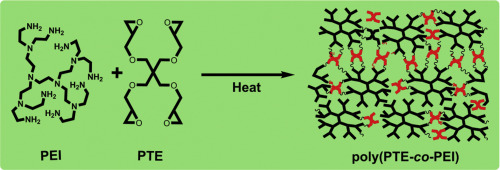当前位置:
X-MOL 学术
›
Anal. Chim. Acta
›
论文详情
Our official English website, www.x-mol.net, welcomes your
feedback! (Note: you will need to create a separate account there.)
The preparation of a poly (pentaerythritol tetraglycidyl ether- co -poly ethylene imine) organic monolithic capillary column and its application in hydrophilic interaction chromatography for polar molecules
Analytica Chimica Acta ( IF 5.7 ) Pub Date : 2017-10-01 , DOI: 10.1016/j.aca.2017.08.025 Ye Chen , Yan Shu , Zihui Yang , Xumei Lv , Wangming Tan , Yingzhuang Chen , Ming Ma , Bo Chen
Analytica Chimica Acta ( IF 5.7 ) Pub Date : 2017-10-01 , DOI: 10.1016/j.aca.2017.08.025 Ye Chen , Yan Shu , Zihui Yang , Xumei Lv , Wangming Tan , Yingzhuang Chen , Ming Ma , Bo Chen

|
An easy single-step thermal treatment "one-pot" approach for the preparation of poly (pentaerythritol tetraglycidyl ether-co-poly ethylene imine) organic monolithic capillary columns was developed successfully. The column was prepared by the epoxy-amine ring-opening polymerization of pentaerythritol tetraglycidyl ether (PTE) with poly (ethylene imine) (PEI) using acetonitrile (ACN) and polyethylene glycol 600 (PEG 600) as the porogenic system at 60 °C for 12 h. The obtained monolith was homogeneous and permeable. It achieved the high-efficiency separation of polar molecules including amides, nucleosides, bases, phenols, and benzoic acids in capillary liquid chromatography (cLC). The highest column efficiency reached ca. 101,000 plates/m (for guanine) on monolith poly(PTE-co-PEI) at 0.64 mm/s, and satisfactory chromatographic performance with column efficiencies ranged from 45,500 to 97,000 plates/m was achieved for the four amides. A typical hydrophilic interaction liquid chromatography (HILIC) retention mechanism was observed with high organic solvent contents (>60% ACN). Also, the polymer-based monolithic column was successfully applied to separate the tumor markers. Furthermore, the poly(PTE-co-PEI) monolith could be easily modified with 1, 2-epoxydodecane, which reacted with the amino groups presented on the surface of the poly(PTE-co-PEI) monolith. Hydrophobic interactions were observed during the separation of alkylbenzenes and anilines on the post-modified poly(PTE-co-PEI) monolith. Together, these results confirm the feasibility of the epoxy-amine ring-opening polymerization reaction during the fabrication of a monolithic column with high efficiency for cLC applications.
中文翻译:

聚季戊四醇四缩水甘油醚-共聚-聚乙烯亚胺有机整体毛细管柱的制备及其在极性分子亲水相互作用色谱中的应用
成功开发了一种用于制备聚(季戊四醇四缩水甘油醚-共聚聚乙烯亚胺)有机整体毛细管柱的简单单步热处理“一锅法”方法。使用乙腈 (ACN) 和聚乙二醇 600 (PEG 600) 作为致孔系统,在 60 °C 下,通过季戊四醇四缩水甘油醚 (PTE) 与聚(乙烯亚胺)(PEI)的环氧-胺开环聚合制备该柱12 小时。获得的整料是均匀的和可渗透的。它实现了在毛细管液相色谱 (cLC) 中对酰胺、核苷、碱、酚和苯甲酸等极性分子的高效分离。最高柱效达到约。101,000 板/米(鸟嘌呤)在整体式聚(PTE-co-PEI)上,速度为 0.64 毫米/秒,四种酰胺均获得了令人满意的色谱性能,柱效范围为 45,500 至 97,000 塔板/平方米。在高有机溶剂含量 (>60% ACN) 下观察到典型的亲水相互作用液相色谱 (HILIC) 保留机制。此外,基于聚合物的整体柱成功应用于分离肿瘤标志物。此外,聚(PTE-co-PEI)整料可以很容易地用 1, 2-环氧十二烷进行改性,它与聚(PTE-co-PEI)整料表面上的氨基反应。在后改性聚(PTE-co-PEI)整料上分离烷基苯和苯胺的过程中观察到疏水相互作用。一起,
更新日期:2017-10-01
中文翻译:

聚季戊四醇四缩水甘油醚-共聚-聚乙烯亚胺有机整体毛细管柱的制备及其在极性分子亲水相互作用色谱中的应用
成功开发了一种用于制备聚(季戊四醇四缩水甘油醚-共聚聚乙烯亚胺)有机整体毛细管柱的简单单步热处理“一锅法”方法。使用乙腈 (ACN) 和聚乙二醇 600 (PEG 600) 作为致孔系统,在 60 °C 下,通过季戊四醇四缩水甘油醚 (PTE) 与聚(乙烯亚胺)(PEI)的环氧-胺开环聚合制备该柱12 小时。获得的整料是均匀的和可渗透的。它实现了在毛细管液相色谱 (cLC) 中对酰胺、核苷、碱、酚和苯甲酸等极性分子的高效分离。最高柱效达到约。101,000 板/米(鸟嘌呤)在整体式聚(PTE-co-PEI)上,速度为 0.64 毫米/秒,四种酰胺均获得了令人满意的色谱性能,柱效范围为 45,500 至 97,000 塔板/平方米。在高有机溶剂含量 (>60% ACN) 下观察到典型的亲水相互作用液相色谱 (HILIC) 保留机制。此外,基于聚合物的整体柱成功应用于分离肿瘤标志物。此外,聚(PTE-co-PEI)整料可以很容易地用 1, 2-环氧十二烷进行改性,它与聚(PTE-co-PEI)整料表面上的氨基反应。在后改性聚(PTE-co-PEI)整料上分离烷基苯和苯胺的过程中观察到疏水相互作用。一起,


















































 京公网安备 11010802027423号
京公网安备 11010802027423号